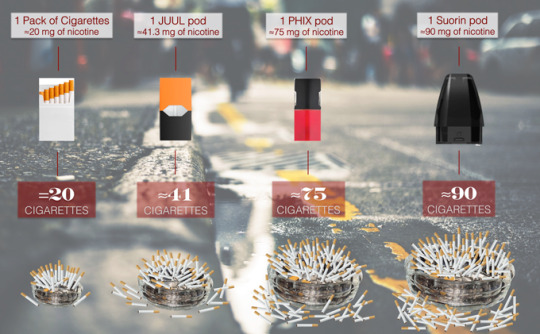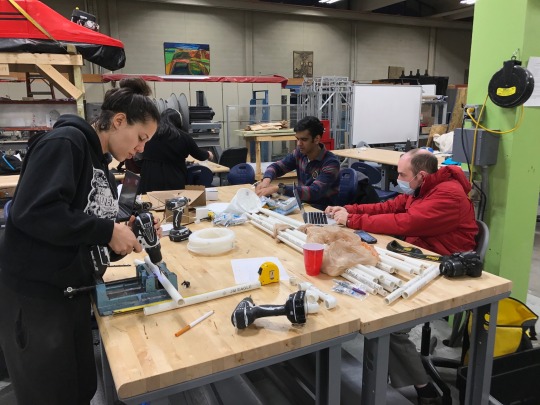#found in the middle of researching for a school project about ng
Explore tagged Tumblr posts
Text

Tom Fulp and Trent Reznor at E3 (2002)
#newgrounds#nine inch nails#tom fulp#trent reznor#2002#old web#old internet#irl photos#found in the middle of researching for a school project about ng
76 notes
·
View notes
Text
Today’s nico-teen addicts: What role does ‘juuling’ play?
Parents may not recognize on sight a JUUL or similar pod-type electronic cigarette, but many of today’s tweens and teens will. These have quickly become the leading vapes of choice for the legions of U.S. e-cig users 18 and under. Vaping isn’t a healthy choice for anyone. And, new data show, these pod-type e-cigs might just be the worst choice of all for kids who have decided to experiment with tobacco products.
U.S. minors cannot legally buy vapes. And that’s one reason the majority of them find these pod-like devices so appealing, says Bonnie Halpern-Felsher. She’s a developmental psychologist at Stanford University in California. These pod vapes have a deceptively large amount of nicotine, she notes.
That nicotine can harm the developing brain, adds Suchitra Krishnan-Sarin. Whether kids know it or not, their brains will undergo a lot of developmental changes between the ages of 10 and 25. Krishnan-Sarin works at the Yale University School of Medicine, in New Haven, Conn. There, she studies how nicotine affects smokers and vapers.
Explainer: The nico-teen brain
Most nicotine research has taken place in rodents. “In adolescent animals,” she notes, “nicotine is a neurotoxin.” It keeps the brain from maturing normally during adolescence. This can harm the ability to learn, to make memories and to maintain attention, she explains. It can even lead to hyperactivity.
Krishnan-Sarin spoke at a news briefing for reporters earlier this year. Adolescent animals, she noted, “are very sensitive to even low levels of nicotine.” And that, she explained, “means they get addicted very easily.” The same, she added, is likely true for human teens.
Yet some kids aren’t aware that pod-like e-cigs contain any nicotine. That was one finding of a new survey. At an October workshop at the National Institutes of Health in Bethesda, Md., Halpern-Felsher and her Stanford colleague Karma McKelvey shared data from their survey of 445 teens and young adults. Each had been asked whether they knew about — or used — pod-like e-cigarettes. The researchers focused on such devices, they said, because JUUL now accounts for between 70 and 85 percent of e-cigarettes vaped in the United States.
Nearly one-quarter of the students said they had vaped. Of those, more than half said they had used JUUL or other pod-like e-cigs. These devices all are really small. And they don’t look like earlier types of e-cigs. Those had resembled mechanical cigarettes or were clunky. JUUL’s sleek pods look a bit like thumb drives. What’s more, they release a relatively small cloud of the vapors from which vaping takes its name.
But these devices hold more nicotine than most earlier e-cigarettes, says Halpern-Felsher. Each JUUL pod, for instance, contains 41.3 milligrams. That’s as much nicotine, she notes, as someone can get smoking 26 to 40 conventional cigarettes (depending on how they are puffed).
Moreover, the salt-based form of nicotine in the pods feels less harsh than the nicotine in true cigarettes and earlier e-cigs. So the pods’ nicotine is less likely to turn off a new user, Halpern-Felsher says. And that may encourage kids to overdo it as they experiment.

Bonnie Halpern-Felsher’s team at Stanford developed this visual illustration of the high quantity of nicotine in several types of pod-based e-cigs — shown in terms of their cigarette equivalence.Tobacco Prevention Toolkit, Stanford Univ.
Some kids are already paying a high price for their covert vaping. Data released Dec. 18 by a federally funded study — Monitoring the Future — finds that 8.1 percent of U.S. 12th graders say they are hooked on vaping. That’s more than twice the 2018 number. What’s more, Halpern-Felsher has found, most teens “don’t recognize how addicted they are.” Some nicotine addicts she surveyed didn’t realize they were hooked at all.
Yet newly emerging data suggest the nicotine delivery by pod-like e-cigs likely makes them at least as addictive as cigarettes.
‘Juuling’ has become a teen thing
Those pods have become so big that they now define much of teen vaping, note Halpern-Felsher and others. Ask kids if they vape and some may say no. To them, she explains, they’re doing something cooler: “juuling.”
Liam Dell, 17, agrees. He’s seen it throughout his Buffalo, N.Y., community. When scientists at the Roswell Park Comprehensive Cancer Center asked this City Honors School student what his classmates were using, “I said JUUL,” Liam recalls. “You can’t get around it as a high-schooler. You see kids using it as they walk down the street. You see it at friends’ houses. You even see it at school. It’s absolutely everywhere.” Kids describe their use of these devices as juuling, he says.
Even some adults may not view JUUL use as conventional vaping, notes Taylor Reed. She’s a research associate who conducts vaping studies in and around New York City. One of her roles, at New York University Medical School, is setting up in-home visits. “Typically,” she says, “on the phone, I’ll ask an adult if anyone [in their home] uses tobacco or nicotine products. And some will say, ‘No, I juul.” They don’t see a pod as a tobacco product.

First-generation vapes (shown left to middle) tend to loosely resemble the cigarettes they had been designed to replace. Later mod-type e-cigs had a bigger well into which people could put custom-selected e-liquids. These vapes also allowed users to boost their temperature for a bigger nicotine hit. Later came the pod-type devices. Though smaller, their innovative use of nicotine salts delivers nicotine more efficiently into the bloodstream, new data show.Tobacco Prevention Toolkit, Stanford Univ.
But the U.S. Food and Drug Administration does. It describes e-cigs as ENDS — short for electronic nicotine delivery systems. Because tobacco is the source of that nicotine, FDA has ruled vapes as tobacco products. Indeed, e-cigs were developed as a way for smokers to wean themselves off cigarettes. Because smokers are addicted to nicotine, e-cigs would help smokers only if they could supply that nicotine.
Yet many teens who never smoked don’t know that, Halpern-Felsher has found.
But Liam does. In fact, he did a study of JUUL’s nicotine as part of his sophomore science fair project. We caught up with him in Pittsburgh, Penn., where his work was being judged as part of the Intel International Science and Engineering Fair. (That fair is a program of Society for Science & the Public, which publishes this magazine.)
Small device, big hits
For his chemistry analyses, Liam used instruments at that nearby Roswell Park cancer center. He confirmed that JUUL vapors carry more nicotine than standard e-cig vapors. His data also show they dispense what he describes as “a more addictive form” of nicotine. Known as non-ionized (Non-EYE-oh-nyzed) salts, it “is able to bond more easily to your lungs and to your brain,” he says. “So you could say it sticks more.”

These boxes of colorful Juul-like pod e-cig systems appeal to teens and young adults. But if users don’t see the packaging, they might not realize that these devices dispense high concentrations of tobacco’s nicotine, an addictive drug.E. Karey
The manufacturer “doesn’t seem to hide the fact that JUUL dispenses high levels of nicotine,” Liam says. It’s on the label. However, the label does not mention what chemical form this nicotine takes. Liam found that “99.4 percent of the nicotine salts were in the non-ionized form. That’s just ridiculously high.” For comparison, he says, “nicotine in e-cigarettes is typically around 80 percent un-ionized.”
He didn’t measure how much of that nicotine ends up in the body. That’s what Jessica Yingst and Jonathan Foulds have just done. These public health scientists work at Penn State Cancer Institute in Hershey. They headed a team that measured blood levels of nicotine before, during and after someone had smoked a cigarette or had taken 30 puffs from an e-cig over a 10-minute period. All the vapers were former smokers.
The vapers used their own devices. In the first of these studies, those recruits used early models of e-cigs. A few of the vapers used so-called cig-alikes (which look somewhat like cigarettes). The rest used advanced “mods.” These allowed users to choose the flavor of liquid they vaped.
Blood levels of nicotine rose as someone vaped. But that average rise (8.2 nanograms per milliliter, or ng/ml) was far lower than in the 10 smokers who each puffed normally on a single cigarette (about 21 ng/ml).
That was “a bit of a surprise,” says Foulds. After all, some of these pre-JUUL devices had vaporized liquids that contained a lot of nicotine. The only explanation, he says, was that these e-cigs “just didn’t deliver nicotine efficiently.”
His team published its findings July 25 in PLOS One.
These data, Foulds realized, might explain why many smokers who had tried vaping went back to cigarettes. Perhaps they just didn’t get a big enough hit of nicotine to sate their cravings.
To test this, his team ran the same trial in six JUUL users. And as soon as the blood data came back, Foulds says, “We went, whoa! That’s a lot of nicotine.” The rise averaged some 28.6 ng/ml.
The Penn State team reported these findings November 15 in JAMA Network Open.
Addiction becomes a real threat
That was a small survey, Yingst admits. Still, she notes, “the nicotine delivery in all six people was pretty similar.” That suggests, she says, they were getting far more nicotine than do users of earlier types of e-cigs. In fact, these new data show, “JUUL delivers nicotine very similarly to a cigarette.”
The company that makes these pods knows that, Foulds adds. His team’s new data are “comparable to what [JUUL Inc.] found in its unpublished data,” he says. The company referred to those data in its patent, he found. He notes that, “[The company] also presented it in a poster at a conference we were at.”
So if these devices deliver as much nicotine as a cigarette, Yingst says, they “would have a similar potential to cause addiction.” In fact, Yingst and Foulds also have just measured the extent to which the JUUL users experience symptoms of addiction. Penn State has a special survey to measure that in users of tobacco products.
Its researchers surveyed cigarette smokers on this 20-point scale. Higher numbers indicate higher levels of addiction. On average, smokers scored a 14, Foulds says. Among users of the pre-JUUL types of e-cigs, the average addiction rating was 8. But among people who vaped JUULs, he notes, the average was 14. These preliminary data now seem to “confirm what many people had suspected,” he says — “that this product is as addictive as a cigarette.”
That should prove as true for teens as for the adults in these studies, Halpern-Felsher says. Yet kids don’t know that, her team finds.
Her group used a different survey to measure addiction. On its 10-point scale, “even scoring a 1 signifies addiction,” she says. And most teen vapers that her team surveyed averaged a 2.5 to 3 on this scale. People who are addicted have a very hard time quitting. Yet these kids don’t realize how dependent they have become on the nicotine they vape.
“They don’t know they’re addicted,” Halpern-Felsher says. “But we do.” She’s published data on this. The young vapers were asked such questions as how quickly did they feel a need to vape after waking? Or did they need to vape even after being told not to use e-cigarettes? “The point is,” she says, “most of today’s youth don’t truly know what addiction means.”
In one October 2018 study, her team assessed how teens and young adults view pod-type e-cigarettes. Ironically, those young people rated the pods “as posing less harm or addictive potential [than other vapes].” At the same time, these so-called juulers showed more nicotine dependence than users of other types of e-cigs.
“It’s just the perfect bad storm,” concludes Halpern-Felsher of juuling.
New trends prompting action
Just eight years ago, teen vaping was virtually unheard-of, note analysts at the Universities of Michigan and Minnesota. They work for that long-running Monitoring the Future program, which has been tracking teen substance abuse for 45 years. Last January 10, they wrote a letter that appeared in the New England Journal of Medicine. In it, they noted that the current growth in vaping seen in high school teens is the greatest jump in nicotine exposures that their program has witnessed in 44 years. Today, more than one in four U.S. high school seniors has at least tried vaping in the past month. The survey’s just-released 2019 data show that more than one in 1 in 10 of these kids now vape daily. Nearly the same share of 8th graders now report they’ve vaped in the past month.
Some states, New York included, have raised to 21 the age at which people can buy vape products. But that hasn’t slowed the rise in teen vaping. Doctors and others are aggressively looking to reverse this trend.
Patrice A. Harris is one of them. This physician is president of the American Medical Association. On November 19, she issued a statement saying, “It’s simple — we must keep nicotine products out of the hands of young people.” That, she explained, is “why we [the AMA] are calling for an immediate ban on all e-cigarette and vaping products.”
On the same day, Letitia James filed a lawsuit against JUUL Labs, Inc. As the attorney general of New York, she has a lot of clout. Her state’s lawsuit charges that “JUUL’s aggressive advertising of its multi-flavored products has contributed to a public health crisis.” Indeed, it argues, this crisis “has left countless New Yorkers — many of them teenagers — addicted to its products and fighting for their health.”
youtube
“How Juul made nicotine go viral” is a historical review of the way the sleek, discrete design of this e-cig brand helped it overtake the e-cig market, especially among teens and young adults.
California’s attorney general also sued JUUL. His office and the city of Los Angeles also argued that this company and other pod-makers have targeted kids. “JUUL and other nicotine product makers must be held accountable” for not preventing sales to underage users, says Los Angeles District Attorney Jackie Lacey.
“There can be no doubt that JUUL’s aggressive advertising has significantly contributed to the public health crisis that has left youth . . . across the country addicted to its products,” noted James. The company’s advertising has been “glamorizing vaping, while at the same time downplaying the nicotine found in vaping products,” she added. “I am prepared to use every legal tool in our arsenal to protect the health and safety of our youth.”
Halpern-Felsher’s team has its own Tobacco Prevention Toolkit aimed at doing this. Its materials can be downloaded free from the Stanford School of Medicine’s website. They describe a wide range of non-cigarette products that can hook kids on nicotine. They also explain how the toolkit can be used to better inform today’s tweens and teens on those risks — hopefully, before they get hooked.
Today’s nico-teen addicts: What role does ‘juuling’ play? published first on https://triviaqaweb.tumblr.com/
0 notes
Photo

5 VERTICAL FARM PROJECTS INCUBATING AT BROWN UNIVERSITY
By Sierra Clark and Amy Ng
Young people want to be farmers, but not in the traditional sense. The emergence of vertical farming, hydroponics, and the local food movement are inspiring college students across the country to think about how to grow food sustainably. At Brown University, multiple groups of students are working on indoor agriculture projects. They are all connected by the desire to do work that matters in a growing field.
Industry Research Leaves Students Skeptical of Vertical Farming
Undergraduate senior Sierra Clark first learned about vertical farms after interning for Indigo, an agriculture tech company in Boston. She grew up on a farm, so it was initially difficult to comprehend growing plants indoors without soil or sunlight. After researching more, she was inspired by the way vertical farming touted to save resources. She kept thinking how her home state of California needed a water-efficient way to grow food, given years of drought. In order to learn more, she created two courses at Brown and recruited fellow students to learn with her.
Through the first course, Research and Education on Vertical Farms, Clark and Melissa Isidor focused on the question of whether vertical farms are a sustainable way to grow food in cities. After visiting multiple farms, speaking to experts, and reading books such as The Vertical Farm and Plant Factory, they were left undecided. Because vertical farms are expensive to build and maintain, the numbers suggested they made most sense in places lacking natural resources, such as the Middle East or Northern Canada. The two students shared their findings by holding monthly Lunch & Learn talks, creating a vertical farm field guide, and putting together a talk called “The Future of Food” which brought Dickson Despommier to campus.
The second course, Business Plans in Indoor Agriculture, was focused on identifying industry problems and needs. A team of four students––Clark, Davin Lewis, Amy Ng, and Zach Pockrose––interviewed 60 growers, suppliers, and academics to collect quantitative and qualitative data. They identified three major problems. First, a lack of standardization is decreasing efficiency of the industry. Many companies have individualized methods or have patented their work which makes industry “best practices” unclear to new and current farmers. Second, capital and operating costs are expensive, while margins are rather slim. Lights and labor are two major cost concerns, which ideally will be slightly alleviated as LED costs decrease in coming years. Third, there exists a huge knowledge gap. Farmers need help with business and marketing, while business people need help growing. The team is writing a business plan addressing this third concern.
Building Systems Illuminates Specific Costs For In-Home Projects
The Lunch & Learn Vertical Farming series led to two different build projects.
Clark, Ng, along with Brown Entrepreneurship graduate student Siddhant Agarwal and Rhode Island School of Design alumnus Ari Kohorn, are building a high-pressure aeroponics system in the basement of a non-profit student housing co-op. The system will use mist rather than a stream of liquid to feed plant roots. Aeroponics is more complex to build, but expedites plant growth due to increased oxygen root exposure. Like any system, aeroponics comes with its challenges such as clogged misting nozzles and the risk associated with power failure––both causes for quick plant death. The team sees the project as a fun learning opportunity that will teach them how to build systems and grow lettuce.

Basic aeroponic system set-up.

From left Sierra Clark, Sid Agarwal, Ari Kohorn. Amy Ng not shown.
Almost all materials were sourced from Amazon, Walmart and Home Depot. They chose T5 fluorescent-powered lights to reduce cost. The system will cost $1,300, and includes a reservoir and two tiers of grow units. The design eliminates a seedling site since seeds are grown directly on fleece attached to each grow unit. They plan to feed the co-op with the lettuce they grow. The students have also built smaller aeroponics systems and a hydroponics system.

Hydroponic system.

Cannabis cloning aeroponic system.
For the second build project, four students created a beautifully designed home-use hydroponics system for a course called Projects in Engineering Design. The team was comprised of four senior mechanical engineers: Cat Hebson, Carrie Manteiga, Josie Natrasevchi, and Kenny Volkmann, who were inspired to build something that could grow food year-round in a small space. This idea was originally sparked by an interest in permaculture and a Lunch & Learn talk which convinced them to use hydroponics instead of soil.

From left Kenny Volkman, Cat Hebson, Carrie Manteiga, and Jose Natrasevchi.

The team laser cut and pieced together the entire structure from scratch. The final product is tall––standing at six feet and made almost completely with wood. The system includes a hidden reservoir tank, a seedling bed and two rows of grow trays. Some neat design features include adjustable lights which can be shifted higher as plants grow, a hidden tilt that allows water to flow through the system while appearing horizontal to the viewer, and a temperature regulation system that notifies users to put in ice cubes when the reservoir water is too warm. The system cost $530 to build and requires $240 per month for energy and water.
PhD Student Project Turns Into A Business Venture
One year ago, Brown PhD Neuro-Engineering graduate, Jacob Komar, became fascinated with the idea of creating a vertical farming business. Komar and his team of three plan to be a major supplier of aeroponics growing systems through their startup Fresh Local 52. The company will sell 1,000 sq ft aeroponic turnkey farms that include an aeroponics system, hardware, and software––all of which function together but can also be purchased as separate pieces.
“Right now, people are buying from a bunch of different vendors. It will be easier and more efficient if people can buy everything from one place,” Komar says.
With four academic degrees in hardware and software, Komar believes Fresh Local 52’s greatest value add will be their control systems. “Currently, there are no turnkey farms that can aggregate data and analyze it in a meaningful way,” he says.
Another major issue with fully integrated systems, Komar found, is cost. Aeroponics systems can cost thousands of dollars, despite being relatively cheap to make. Fresh Local 52 is committed to bringing quality farm products at the lowest price possible.
About the Authors: Sierra Clark is a senior at Brown University graduating with a degree in cognitive neuroscience. Her work outside of school is focused on sustainable agriculture and nutrition. Previously she has worked for agriculture tech and digital health companies. In the future she plans on starting her own sustainable farm and offering educational services to future farmers.
Amy Ng is a senior at Brown University graduating with dual degrees in business and environmental studies. Amy is dedicated to food security and interested in providing sustainable agriculture services to undeveloped countries. They* plans to work with Sierra in closing the knowledge gap for future farmers.
*preferred pronoun
To learn more about these courses or student projects, please contact Sierra Clark at [email protected].
#Amy Ng#Sierra Clark#Brown University#Agritecture#Vertical Farming#Aeroponic#Hydroponic#entrepreneurship#student#Design#Cannabis Cloning#Brown Entrepreneurship#Indoor Agriculture#Business Plans#original content
5 notes
·
View notes
Text
Social media in 2020: 11 data-backed predictions
2020—it’s a year that, because of its symmetrical numerology, tends to attract a disproportionate share of futurist musings.
Not wanting to be left out (as well as to capitalize on the SEO term “social media in 2020”), I’ve made a list of how social media will evolve in the coming years.
From the rise of social commerce to Gen Z stumbling into an office chair near you, this post will tell you what social trends to expect and prepare for.
In this post, I’ll offer broad strokes. If you’d like a more comprehensive analysis of social media trends, see my 2018 social trends report. In the report, I cover social video, the state of peer-to-peer trust, ROI measurement, and key opportunities for each major social platform.
#1 – Social’s growth continues
We Are Social and Hootsuite recently published our annual global study of internet, social, and mobile adoption across 239 countries.
In our analysis, we found that social media usage will continue to grow. 1 million new people joined social networks every single day in 2017. And nearly a quarter of a billion new users came online for the first time in 2017. This growth will continue—and we’ll see interesting uses of social media come from countries like Africa which currently has the fastest growth rates, with the number of internet users across the continent increasing by more than 20 percent year-over-year.
By 2020, we’ll see the increased dominance of Instagram, especially among older demographics. “Instagram users are a lot more older than people often imagine,” says Simon Kemp. “There are more 45 to 54 year-olds using Instagram than there are 13 to 17 year olds.” As our CEO Ryan Holmes predicts, Instagram will quickly evolve over the next few years and become the new home for brands.
You can take a closer look at this data in our global report (in partnership with We Are Social and Simon Kemp).
#2 – Product discovery becomes more visual (and social)
According to GlobalWebIndex, almost half of internet users follow brands they like or brands they are thinking of buying something from on social media. Search engines, online reviews, and PR are the traditional discovery channels. But by 2020, we’ll see dramatic growth in five areas:
Social for product research
For online product research, search still leads the way. But social is catching up.
In a study of 178,421 global internet users aged 16-64, GlobalWebIndex found that 28 percent of users turned to social networks during their online product research, a number that we’ve seen jump every year.
In fast-growth markets such as Latin America, the Middle East, and Africa, social media dramatically beats search engines for product research.
As GlobalWebIndex also found, social media eclipses search engines as a research channel in the Philippines, Kenya and Morocco.
By 2020, we’ll see search’s grip slip further on product research and social’s influence grow, especially among mobile-first consumers and emerging markets.
Visual searches
Andrew Ng, the Chief Scientist at Baidu, predicts that at least 50% of searches by 2020 are going to be through images or speech.
Products like Pinterest Lens use machine learning to aid in brand and product discovery. As Pinterest’s founder and CEO Ben Silbermann puts it, “a lot of the future of search is going to be about pictures instead of keywords.”
Voice control
“Who ever controls voice is going to control a quarter of all computing,” predicts Stern School of Business professor Scott Galloway.
But as Simon Kemp also points out, the transformation that voice technology will bring goes far beyond brands fighting for digital shelf-space on Amazon Echo.
As he explained in a recent podcast, especially for emerging markets, voice will help to make searching (and typing) easier. Voice technology helps consumers who have lower levels of reading literacy, making it a key technology for the next billion consumers about to come online for the first time. This will both change how consumers discover products and how they communicate on social channels—a new set of digital behaviors that marketers will need to adapt to.
Messaging apps
Facebook predicts that by 2020, 80 percent of smartphone users are projected to be using a mobile messaging app. Customer service is one of the most obvious use cases. But many local businesses are using messaging apps as their primary customer communication hub. This opens the door for conversational commerce to extend far beyond messaging, with messaging apps becoming the center of mobile commerce, customer relationship management workflows, and product discovery.
Chatbots
From product galleries on Instagram to product launches on Facebook Live, social content is already used by younger demographics to discover and evaluate products. As more consumers research potential purchases on social networks, it’s a short leap to buying directly on Facebook, Pinterest, or Instagram.
Chatbots will help consumers transition to social commerce, making it easy and seamless to discover products, ask questions, process digital payments, and see automatic updates on your order’s delivery date.
By 2020, the novelty of chatbots will be gone. But for purchases such as choosing a smartphone package or planning a vacation, they’ll be delightfully helpful shopping social companions.
#3 – Social video saturation—and evolution
“Over the next few years, the much bigger driver of the business and determinant of how we do is going to be video, not Messenger,” says Mark Zuckerberg.
It’s easy to see the growth potential of video. According to GlobalWebIndex’s latest data on social video adoption, audience demand continues to grow.
56% of internet users watch videos on Facebook, Twitter, Snapchat or Instagram each month.
81% of 55 to 64-year-olds are watching videos online each month.
One in three social video viewers watch videos made by brands every month.
As more mobile-first consumers in emerging markets come online, we’ll see even more growth in this area. For countries with low literacy rates, video is a much easier medium than text to learn about products and communicate online.
And with the rise of messaging—a medium where people type less and increasingly use audio snippets, live video messages, and augmented reality filters—the opportunity of social video has only begun.
But by 2020, marketers will face video saturation. As we found in our 2018 Social Trends survey, 46 percent of respondents said they’re already implementing social videos, with another 26 percent planning to implement in 2018. This means that social video is quickly moving from being an algorithmic advantage to a table-stakes tactic.
While most brands use social videos to boost traffic and reclaim a bit of organic reach, the impact of social video will be broad. Here are a few areas to expect to see radical transformation with social video content.
Social ecommerce
Nearly every consumer is primarily using a mobile device. And video is a much easier medium for learning about products. Companies like MikMak are working to figure out what native commerce experiences look like for “the social video generation.”
With fun, short-form product videos, they help brands directly convert viewers on social channels. Expect to see more companies shorten the path between awareness videos and direct purchases on social platforms.
One-to-one communication
Whether chatting with an investment advisor or getting a sales agent to walk you through cell phone plans, there’s a lot of opportunity for one-to-one videos between businesses and consumers.
For example, teens are typing less in messaging apps and using videos and audio snippets more. Over 100 million people use WhatsApp’s in-app video calling to connect with friends and family. Over 200 million people use the video messaging and augmented reality app Snow.
Marketers will need to adapt to these new highly personal uses of video. In other words, social video will need to become social—an experience that builds a customer community rather than broadcast-style content and product teasers.
Passive networking
Globally, online consumers spend one-third of their time on social media. But as people spend more time on social, we’re seeing new behaviors emerge.
People are sharing less personal information on major networks. Instead, they’re watching videos, killing time, and sharing things to connect with friends.
Video’s impact will be broad here.
As GlobalWebIndex puts it in their latest social video report, “video positions social media as the go-to destination for anything from music consumption to online shopping and live sports broadcast and commentary.”
What to do to prepare:
Social videos can boost traffic. But chasing traffic and adapting to the whims of social algorithms isn’t a winning strategy.
“Only two firms can monetize traffic at scale—Facebook and Google,” says Stern School of Business professor Scott Galloway. “Everyone else needs to build a group of loyal followers.”
If you’d like practical tips for using video in 2018, I analyzed the state of social video in Hootsuite’s 2018 Social Trends report.
#4 – Social commerce makes a new push
Social commerce adoption in Europe and North America has been slow. But the next phase of innovation in social won’t come from advanced economies. It’s the emerging economies—consumers that have skipped desktop and traditional search engines—that will lead the way.
From micro businesses to major retailers, social’s role in ecommerce will grow. For example, Instagram already allows businesses to build digital storefronts with visual and video content.
As the analyst firm GlobalWebIndex predicts, “shopping via social channels may be an APAC-based phenomenon for now, but a culmination of trends are laying the groundwork for social commerce to gain traction in the West.”
What you can do to prepare:
Make sure your social video and social commerce strategy are working in lock-step. Mobile-first shoppers look for fun, short-form product videos.
I also found this report by the consulting firm PWC to be valuable. It shows how mobile-first consumers are using social across the complete customer journey in China, a glimpse of the trends that will soon sweep Europe and North America.
#5 – Gen Z drives VR and AR adoption
By 2020, we’ll see more practical uses of virtual reality (VR) and augmented reality (AR) in marketing. Amazon, for example, are exploring how to use AR to help consumers to try on virtual clothes and explore products. Snapchat’s Geofilters and Lens functions have been broadly adopted in marketing campaigns including creating location-specific videos to influence nearby customers such as event attendees or pedestrians near a store location.
Gen Z, of course, will help to push these technologies further. As GlobalWebIndex found, 22 percent of Gen Zers are using geofilters each month. Gen Zers who are watching social videos each month are 40 percent above average for using online sources to research products. They also are influenced by social reviews, admitting that lots of “likes” and positive comments on social media motivates them to make a purchase.”
Social platforms will obviously continue to push mobile AR features, as novelty always boosts user engagement (both for new features and ad campaigns by early adopters). Facebook Messenger, WhatsApp, Instagram, Snapchat, Bitmoji, WeChat, and QQ are social messaging platforms that will use AR to boost advertising revenue.
What you can do to prepare:
TechCrunch released a bullish look at how VR and AR technologies will impact businesses. It’s packed with platform revenue data and interesting examples of how the mobile AR user base will push the market forward.
#6 – Social CEOs become the new normal
From the rise of anonymous work apps like Blind to collaborative digital spaces like Facebook Workplace, it’s clear that social is already changing how employees work.
By 2020, we’ll see the greatest impact on two areas: employer branding and the rise of executives who understand—and know how to use—social to listen to customers, communicate their vision, and rally employees.
It’s clear that the floodgates have opened. Employees are vocal. They have immediate social reach. And employees can easily build—or pull down—an employer’s brand. By 2020, large organizations will realize that employee comments and perceptions on social will need to be managed similar to how companies monitor customer complaints and feedback.
Whether tracking employee perceptions of new leaders to prioritizing critical problems in corporate culture, social data will become a new area of advantage. Using publicly available data (such as comments on Instagram or perceptions on LinkedIn), social data will provide a true look into the health of an employer brand.
Key to this transformation will be the ability of CEOs and other leaders to use social to communicate directly with employees. And by 2020, CEOs with tepid professional adoption of social media will become more rare.
As social channels continue to grow as the dominant communication channels both within and outside of company walls, CEOs who ignore these channels will be at a disadvantage.
In this new world, leaders will also need to adapt their communication styles. Be personal, unscripted, and direct. For example, Edelman’s study of consumer trust found that 57 percent of global consumers were more likely to believe a spontaneous speaker, versus 43 percent that would trust a speaker that sounded scripted and rehearsed.
What you can do to prepare:
Our CEO Ryan Holmes wrote a short primer for executives, teaching you how to build an effective social leadership strategy.
In Edelman’s 2018 report, you can track the role that employees have in corporate communications. You’ll also see global data on how CEOs can build more trust with today’s social employees and vocal consumers.
#7 – Amazon makes a move on the advertising duopoly
By 2020, we’ll see digital dominance of Google and Facebook slightly shrink, while Amazon’s and Snapchat’s influence grows. According to the analyst firm eMarketer, Amazon’s ad business is expected to grow to nearly three percent of the market from two percent in 2017, for a total of $2.9 billion in ad revenue for 2018.
Amazon has built the world’s largest digital storefront. They’ve also studied billions of digital shopping behaviors. And now, they’re working to earn advertiser dollars. Amazon’s key advantage is attribution.
“Amazon’s pitch,” explains the marketing magazine Digiday, “is that it can offer advertisers a ‘total wallet’ perspective—connecting what people are searching for with what they’re buying online—and with its increasing brick-and-mortar retail presences, also what people buy in person.”
Organic social content will play a critical role, helping shoppers to evaluate products, be inspired by curated product collections, and seek advice from like-minded customers.
As the analyst Mary Meeker predicts, “Ads are becoming targeted storefronts. Ads, content, products, transactions … the lines are blurring. The content is becoming the store. The ad is becoming the transaction.”
What you can do to prepare:
Take a look at Amazon’s advertising platform. Explore Snapchat’s self-serve advertising features. And also take a look at Hootsuite Ads—our tool helps you effectively manage organic and paid content together, reaching a bigger audience at a lower cost.
#8 – The machines serve their masters
“Artificial intelligence will be everywhere, like electricity,” says the Lady Gaga of Mathematics, Cédric Villani. At the end of April, Villani will release his highly anticipated report that will help to guide how governments prepare for the AI evolution that is already moving beneath our feet.
Companies like Google, of course, will make sure this dream becomes real.
“In the long run, we’re evolving in computing from a ‘mobile-first’ to an ‘AI-first’ world,” says Sundar Pichai, CEO of Google.
Gartner has been bullish on their AI predictions. They estimate that by 2020, 30 percent of all B2B companies will employ artificial intelligence (AI) to augment at least one of their primary sales processes.
So what does AI mean for the future of marketing? One of the best decks on AI I’ve found comes from the analyst and general-smart human Simon Kemp. In this fantastic deck workshop, you’ll learn how to adapt your marketing to a machine-first world.
In broad strokes, algorithms already influence almost every aspect of our digital lives including what content we read, what products we discover, and even who we marry. The good news is that from chabots to predictive analytics, many AI innovations will help marketers increase their impact while eliminating tedious tasks.
And while understanding how algorithms push our content or products higher in social feeds, Simon Kemp reminds us to keep things simple. As he explains, “many marketers think of algorithms as incomprehensible ‘black boxes’, but they’re actually more predictable than the irrational behaviour of human consumers. Treat algorithms as just another ‘audience’ and many of your fears will dissipate.”
What you can do to prepare:
Take a look at Simon Kemp’s AI workshop. Also start exploring tools that use AI—for example, MarketMuse uses AI to help build smarter SEO and content strategies. Companies like Conversable make it easier for brands who use AI to create automated experiences on messaging and voice channels.
I’ve also found a lot of value in Narrative Science’s Quill, an AI-based app that turns data into written reports. You can sign up for their free version here. The free app analyzes your Google Analytics data including custom segments. It’s a great way to automate monthly KPI reports for leadership.
#9 – Emerging markets innovate with mobile
“The next billion users as they come online are going to change absolutely everything in terms of the way that all of us experience the internet—this is not just a next billion developing economy story but very much about the future of the internet and global connectivity for all of us,” says Simon Kemp.
By 2020, Facebook predicts that more people are predicted to have mobile phones than running water or electricity at home. An estimated 3 billion people will gain access to mobile phones by 2020. For these consumers, mobile will be their only way to get online. According to Facebook, more than one in four internet users measured are already mobile only, with India (70 percent) and Indonesia (67 percent) leading the way.
Messaging apps will play a key role in this mobile-centric world, giving micro businesses new ways to communicate with customers.
“Many emerging markets have leapfrogged past landlines and computers, building their own mobile-centric universes,” says Facebook. “Among people surveyed who are connected in Kenya, Nigeria and South Africa, fully 40 percent say they’ve been able to generate additional income from being online.”
For example, Facebook found that consumers in India, Mexico and Thailand are 1.25 times more likely to say that the ability to message a business makes them more likely to shop with that business. Kenyans surveyed are 1.57 times more likely than the global average to use mobile payments.”
As I already mentioned, 80 percent of smartphone users are projected to be using a mobile messaging app by 2020. But as Facebook’s research found, people are already using messaging apps to pave new paths to purchase.
Social networks will also play critical roles in the financial lives of mobile-first consumers.
For example, TransferWise allows users to send money internationally via Facebook Messenger chatbots—the latest in a long line of social integrations. Almost two in three messaging app users are currently using mobile banking services according to GlobalWebIndex. And 63 percent of messaging app users are also using mobile banking services.
I also analyzed the key social trends in the financial sector in our yearly report. You can download that report here.
By 2020, we’ll see digital communication dramatically evolve. As Simon Kemp explains, “keyboards will be replaced by voice commands and cameras. Visual content will dominate social and messaging, and new technologies will offer richer digital experiences for people everywhere. To keep up, brands need to rethink their strategies, build new capabilities, and quickly adapt.”
What you can do to prepare:
Brands know that mobile is the default experience. But according to research from the analyst firm L2, few brands have moved beyond basic optimization. L2 found that the average mobile checkout process is three pages long, giving users (especially in lower literacy markets) lots of reasons to click away in frustration. Only 14 percent of consumer brands offer single-page checkouts.
To adapt to mobile-first consumers, begin with the basics. Audit your mobile experience. Begin using social commerce like Instagram’s shopping features. And look to emerging markets to prepare for the next shifts in mobile and social commerce. In our global report, you can drill down into regional countries, seeing how mobile-first economies use social channels.
#10 – Fake news and the rise of regulation
By 2020, the major platforms will be regulated. But the news headlines will also resemble 2018—Trump will be charging towards reelection which means you’ll be seeing a lot of articles about fake news, data privacy, and Russian hackers.
As eMarketer notes, marketers will also face stricter regulation and the market will be filled with tech vendors in order to protect and store first-party data. We’re already seeing the impact of regulation. Facebook, for example, will soon require marketers to confirm they have user consent for Custom Audiences.
It’s the end of the wild west. Social platforms will be regulated. Governments and consumers will look to better guard personal data. And rather than being impressed by data journalism or clever personalization, tech companies will be seen in a darker light by the public.
What you can do to prepare:
If you’ve never even thought of the implications of the General Data Protection Regulation (GDPR), the Information Commissioner’s Office (ICO) in the UK has released a 12-point guide.
If you love Trump, you’ll be happy in 2020 as I think he will win a second term. If you aren’t a fan, consider moving to Canada. I’m already here. And there are a few empty desks by me.
#11 – Gen Z are the future—unless we stop them
It’s too late to stop millennials. By 2020, they’ll by far be the largest cohort in the workforce. “Millennials have officially overtaken Gen Xers as the most populous generation in the US workforce,” reports Facebook and Deloitte. “By 2020, they will make up half of the global workforce.”
I’m technically a millennial. So I’m not worried about millenials. And by 2020, the avocado toast and snowflake jokes will be forgotten in some internet archives. Instead, we’ll be in the middle of the new generational wave—the socially-wired Gen Z.
But don’t worry—my nephew is a member of Gen Z. Can’t say enough nice things about him.
What you can do to prepare: There is nothing you can do. They’re already among us.
In the meantime, if you want to understand your future boss, here’s a report with a few things to understand about the media’s new generational scapegoat. Hootsuite has also compiled some helpful statistics about Gen Z.
Not all trends are worth following.
Here are a few resources to help guide your digital strategy in 2018 that I mentioned in this article.
Digital in 2018 Download Hootsuite and We Are Social’s global report on internet, social, and mobile adoption across 239 countries.
Hootsuite’s Social Trends 2018 You can download my yearly trends report filled with global data, visual charts, new tools, and key trends to put into action.
Social Trends for Financial Services Hootsuite’s financial service report examines key industry trends, tracking how organizations are using social media to grow revenues and decrease operational costs.
We promise social media will still exist in 2020. And you’ll still be able to manage all your accounts in one place via the Hootsuite dashboard. Try it free today.
Get Started
The post Social media in 2020: 11 data-backed predictions appeared first on Hootsuite Social Media Management.
Social media in 2020: 11 data-backed predictions published first on https://themarketingheaven.tumblr.com/
0 notes